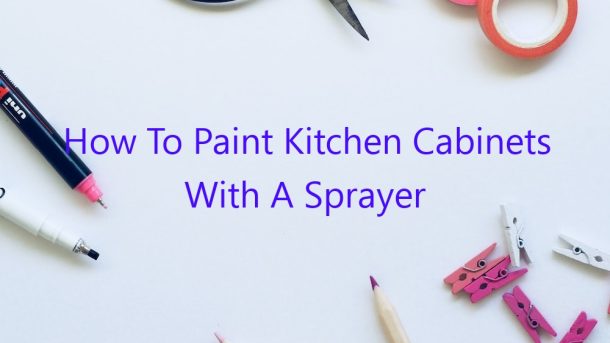So you’ve decided to paint your kitchen cabinets. Great choice! Not only will a fresh coat of paint give your kitchen an instant facelift, but it can also be a cost-effective way to update your space.
But what type of paint should you use? And how should you go about painting your cabinets?
In this article, we’ll walk you through the process of painting kitchen cabinets with a sprayer.
How to Choose the Right Paint for Your Cabinets
When it comes to painting kitchen cabinets, there are a few factors to consider when choosing the right paint.
First, you’ll need to decide what type of paint you want to use. There are three main types of paint to choose from: latex, oil-based, and alkyd.
Latex paint is the most popular type of paint, as it’s easy to use and cleans up easily. It also dries quickly and is affordable.
Oil-based paint is more durable than latex paint and can be used on both interior and exterior surfaces. However, it’s also more expensive and can be difficult to work with.
Alkyd paint is the most durable type of paint, but it’s also the most expensive. It’s also the most difficult to work with, as it dries slowly and requires a lot of preparation.
Second, you’ll need to decide what color you want to paint your cabinets. If you’re not sure what color to choose, you can browse paint color samples or take a look at your kitchen’s existing color scheme.
Finally, you’ll need to decide if you want to use a gloss or matte finish. Gloss finishes are more durable and easy to clean, while matte finishes are less durable but look more natural.
How to Paint Kitchen Cabinets with a Sprayer
Once you’ve chosen the right paint for your cabinets, it’s time to start painting. Here’s a step-by-step guide to painting kitchen cabinets with a sprayer:
1. Remove all of the cabinet hardware.
2. Sand the cabinets thoroughly.
3. Clean the cabinets with a degreaser.
4. Prime the cabinets.
5. Paint the cabinets.
6. Add a sealant.
7. Reattach the cabinet hardware.
1. Remove all of the cabinet hardware.
Before you start painting, you’ll need to remove all of the cabinet hardware. This includes cabinet pulls, knobs, and hinges.
2. Sand the cabinets thoroughly.
Before you start painting, you’ll need to sand the cabinets thoroughly. This will help the paint adhere to the surface of the cabinets and will give them a smooth finish.
3. Clean the cabinets with a degreaser.
Before you start painting, you’ll need to clean the cabinets with a degreaser. This will remove any dirt or grease from the surface of the cabinets.
4. Prime the cabinets.
Before you start painting, you’ll need to prime the cabinets. This will help the paint adhere to the surface of the cabinets and will give them a smooth finish.
5. Paint the cabinets.
Once the cabinets are sanded, degreased, and primed, it’s time to start painting. You can either use a brush or a sprayer to paint the cabinets.
If you’re
Contents
- 1 Is it better to spray or brush paint kitchen cabinets?
- 2 What kind of paint is used to spray kitchen cabinets?
- 3 Is spray painting kitchen cabinets a good idea?
- 4 How do you prep cabinets for paint sprayer?
- 5 How do you spray paint cabinets like a pro?
- 6 How do I get a smooth finish on kitchen cabinets?
- 7 Is it better to hand paint or spray cabinets?
Is it better to spray or brush paint kitchen cabinets?
There are pros and cons to both spraying and brushing on kitchen cabinet paint. It can be tough to decide which is the better option, but knowing the pros and cons of each method can help make the decision a little easier.
Spraying kitchen cabinet paint is a faster process. The paint is distributed more evenly and thinly with a spray gun than it is when brushed on. This can result in a neater finish with no streaks. However, there is a greater chance of overspray with spraying, and it can be more difficult to get into all the nooks and crannies with a spray gun.
Brushing kitchen cabinet paint is a slower process, but it can be easier to achieve a more even finish with less risk of streaks. It is also easier to get into all the nooks and crannies with a brush. However, brush strokes can be more visible than with spraying, and it can take more time to cover all the surfaces with paint.
What kind of paint is used to spray kitchen cabinets?
In order to spray kitchen cabinets, you will need to use a type of paint that is specifically designed for this purpose. Latex paint is generally used for spraying cabinets, as it is easy to work with and creates a smooth, even finish. You will need to choose a color that will complement the rest of your kitchen décor, and you may also want to consider using a varnish or sealant to protect the paint from scratches and blemishes.
Is spray painting kitchen cabinets a good idea?
Spray painting kitchen cabinets can be a great way to update the look of your kitchen without spending a lot of money. However, there are a few things you should keep in mind before you decide to take on this project.
The first thing to consider is the type of paint you will use. There are a few different options, but polyurethane paint is a good choice for kitchen cabinets. This type of paint is durable and will last for years.
Another thing to keep in mind is the color of the paint. It’s important to choose a color that will complement the rest of your kitchen. If you’re not sure which color to choose, you can always ask a professional for help.
Once you’ve chosen the right paint and color, it’s time to start spraying. Be sure to follow the instructions on the can carefully, and take your time when spraying. If you’re not careful, you could end up with paint drips or streaks.
Once the paint has dried, you can start putting your cabinets back together. Be sure to test the paint before you start putting everything back in place. If you’re not happy with the results, you can always paint over the paint job.
Overall, spray painting kitchen cabinets can be a great way to update your kitchen without spending a lot of money. Just be sure to follow the instructions carefully and take your time.
How do you prep cabinets for paint sprayer?
Anyone who has ever tried painting cabinets by hand knows how difficult and time-consuming it can be. This is why many homeowners choose to use a paint sprayer instead. However, if you don’t properly prepare the cabinets for paint sprayer, you may end up with a mess on your hands. Here is how you can properly prepare your cabinets for a paint sprayer:
1. Remove all hardware from the cabinets. This includes knobs, hinges, and pulls.
2. Clean the cabinets thoroughly. Use a degreaser or a soap and water solution to remove all dirt and grease.
3. Sand the cabinets. Use a medium-grit sandpaper to sand all surfaces of the cabinets. Be sure to sand in the direction of the wood grain.
4. Prime the cabinets. Use a primer that is designed for wood surfaces.
5. Paint the cabinets. Use a paint sprayer to apply a coat of paint to the cabinets.
6. Reattach the hardware. Once the paint has dried, reattach the hardware to the cabinets.
How do you spray paint cabinets like a pro?
If you’re looking to give your cabinets a fresh, new look, spray painting may be the way to go. But spray painting cabinets can be tricky – if you don’t do it correctly, you could end up with a mess on your hands.
Here are a few tips on how to spray paint cabinets like a pro:
1. Start by removing all of the cabinet doors and drawers, and sanding down the surfaces you’ll be painting. This will help the paint adhere better.
2. Next, tape off any areas that you don’t want to paint, such as the hinges, handles, and seams.
3. Apply a coat of primer to the surfaces you’ll be painting. This will help the paint adhere better and will also help to cover up any existing paint or stains.
4. Once the primer has dried, apply a coat of paint to the cabinets. Be sure to use a brush or roller to apply the paint evenly.
5. Let the paint dry completely, then reattach the doors and drawers.
If you follow these tips, you’ll be able to spray paint your cabinets like a pro!
How do I get a smooth finish on kitchen cabinets?
It can be challenging to get a smooth finish on kitchen cabinets. There are a few things you can do to help you achieve the results you are looking for.
One of the most important things to do is to make sure the surface is clean and free of dust and dirt. You may need to clean it with a degreaser or cleaner to get it ready to paint.
You will also need to sand the surface to help the paint adhere to the surface. Start with a medium grit sandpaper and work your way up to a finer grit sandpaper. Be sure to sand in the direction of the wood grain.
Once the surface is clean and sanded, you can start to paint. Use a primer to help the paint adhere to the surface and to help it last longer. Be sure to paint in the direction of the wood grain.
If you are looking for a high-gloss finish, you may need to apply a few coats of paint. Be sure to let each coat dry completely before applying the next one.
To help keep your cabinets looking smooth, you may want to apply a sealer or top coat once the paint has dried. This will help protect the finish and help keep it looking smooth.
Is it better to hand paint or spray cabinets?
Is it better to hand paint or spray cabinets?
This is a question that many homeowners face when they are remodeling their kitchens. There are pros and cons to both methods, and the final decision depends on a variety of factors.
Hand-painting cabinets is a more time-consuming process, but it can yield better results. The painter has more control over the finished product, and can ensure that every corner and crevice is covered. In addition, hand-painting allows for more intricate designs and details.
However, hand-painting can also be more expensive, since it requires more labor. It is also a less efficient method, since it can take longer to paint a large number of cabinets.
Spraying cabinets is a faster and more efficient process, and is less expensive than hand-painting. However, it can be difficult to achieve a smooth finish, and the end result may not be as polished. In addition, spraying can cause paint to drip or run, and can create streaks and marks.
Ultimately, the best method for painting cabinets depends on the individual homeowner’s needs and preferences. If time is not a factor, and a high-quality finish is important, then hand-painting is the best option. If speed and efficiency are more important, spraying is the better choice.




